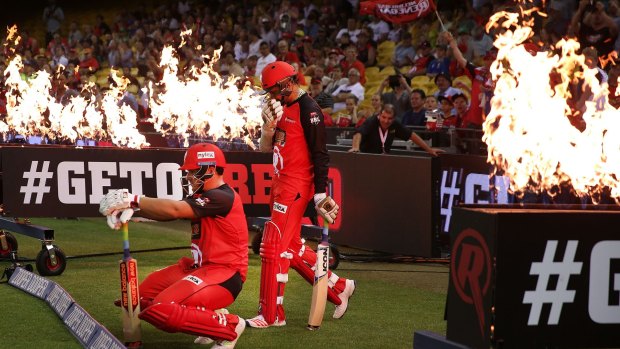By Greg Baum
Measured by average crowds, the Big Bash League is now the sixth-biggest sporting competition in the world.
Attendances are up 5 per cent on last year, which in turn was a 25 per cent increase on the year before. Saturday night's Sydney derby at the SCG is expected to be the 12th sell-out of the season. Yes, fewer teams play fewer matches in bigger stadiums in a smaller window than other sports, making for a delirious concentration. But – let's be honest – repeat crowds at any sort of cricket is its own gratifying novelty. Ratings, too, are robust, though plateauing this season, which organisers say is due to fixturing quirks that the finals will iron out.

The Big Bash League is on fire.Credit: Getty Images
The BBL has defied sceptics – this column included – and grown bigger, sooner even than Cricket Australia foresaw, which means that six years on, it is like the bloke who takes a catch in the crowd, disbelieving of himself.
No one really knows what we've got here. Perhaps it doesn't bear analysis. Perhaps it doesn't need analysis. Perhaps it needs no more explanation than one respondent's exclamation to Adam Gilchrist on Twitter after the astonishing game at Etihad Stadium on Thursday night: "Wahoo!!! I didn't even care who won, that was amazing." Twitter, you must understand, is a universal KPI now. Crucially for cricket, the tweeter was a woman, a mother.
In CA's annual report, chief executive James Sutherland said: "We continue to hold to our long-term position that fans want context and relevance from the games they watch."
But do they? The rules have changed, the dynamics, too. Each BBL team is a fluid mish-mash of former and future internationals, chancers and project players, has-beens, wannabes and never-weres, turning over constantly. Test players appear, but are not necessarily or even often the stars. Once, this sort of troupe would have alienated fans, but not here, not now. Their attachment is happily loose. Not after either of the Melbourne derbies was there a sense of people walking away kicking the ground in disgust. Perhaps that will come. In the meantime, the involvement is the thing; see "wahoo", above.
Test fans are involved, but more subtly. Intent silence is involvement, a hush is a noise there. So this is a different crowd, not taking from Test cricket, but adding to the game's quantum, as CA had predicted.
The cricket itself is what it is; what you see is what you get. Actually, it's more than that. Batsmen have always had some of the hitting skills now on display, but didn't dare use them in a match (Mike Gatting's reverse sweep in the 1987 World Cup final probably set back enterprise 20 years). Now they daren't not use them.
Contrary to impressions, there are nuances. The best six bowlers this season, as gauged by economy rates, are spinners, and so are 15 of the best 20. The worst is the fastest, the ever-lost Shaun Tait. And don't sniff at the economy-rate metric: in a game in which a dot is a jab, each increment counts. Ashton Agar did not take a wicket for the Scorchers at the Gabba the other night, but during his well-aimed spell, the Heat's innings withered away.
Besides, for those unmoved by little movement, soon enough, another six will happen along. The six is T20's foremost trope, not just a shot, but a show, to the point that a one-bounce four now is received as something of a let-down. The way modern sporting has evolved, individuals do transcend teams and games, whatever the coaches' cliches say, and so do individual moments. Again, cricket authorities read this right.
Just quietly, it was always so. More than 100 years ago, one E.V Lucas wrote, heretically: "Yet even from the pedant what a deep ecstatic sigh, when the batsman jumps to meet one, and a sixer climbs the sky." The only difference now is licence, and the liberal taking of it.
The BBL seems to have caught the zeitgeist. This week, English officials were in town to take notes, and so was the Carribean Premier League. Expansion is being mooted. The odd thing is that contemplations of the BBL are still made in terms of an experiment, a prototype, a kite to fly. Perhaps us fuddy-duddies are to blame.
The last irruption of this scale in the program was the World Series, the annual triangular 50-over tournament that grew out of World Series Cricket. Six years in, no one was thinking of it as fly-by-night. It would run as a staple for another 25 years. Fifty-over cricket began to dull when cricketers found safe ways of playing it. For now, there is no safe way to play T20, blessedly.
So, the question no longer is whether the BBL is good for the game. It is whether it is the game now. Allowing for a certain degree of being swept up in the rush, in the last month it has felt that way.